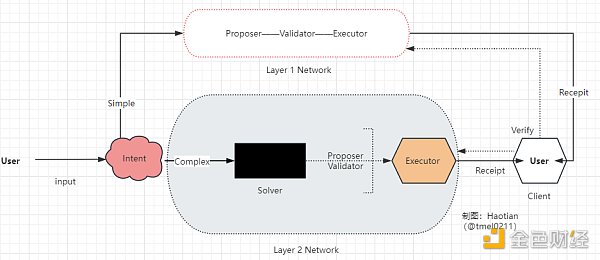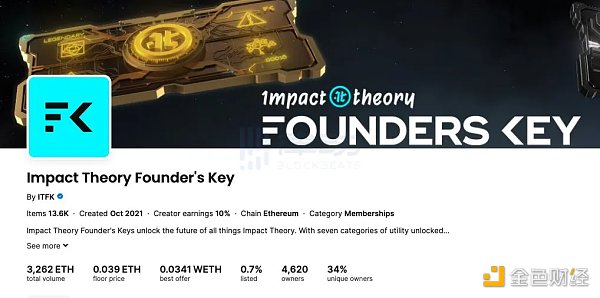In-depth Analysis The Smart Architecture of the Next-Generation Blockchain
Next-Generation Blockchain Smart Architecture AnalysisAuthor: HAOTIAN-CRYPTOINSIGHT, Source: Haotian-CryptoInsight’s Substack
On the surface, “Intent-centric” only focuses on the results and does not care about the process. In reality, the process is hidden in a “black box” by higher technology. Today, let’s take a distributed Intent Architecture as an example to dissect the Workflow of this black box. The content may be dry, so it is recommended to like it before reading.

This is likely to represent the “smart” architecture of the next generation blockchain.
- Summary of Token2049 Asia Blockchain Week Events in Mid-September (Part II)
- NFT completely cold? Analyzing the actual transaction data of the past two years
- Interoperability and Bridging in Blockchain Current Status
In the early days of the internet, there were also black boxes, such as few people understanding the communication principles of internet technology protocols such as HTTP, TCP/IP, CDN, IPV6, etc., but everyone was immersed in the applications on the upper layer. In the web3 era, it also needs to go through a process of hiding the backend protocols. This is what Intent-centric is doing. Only in this way can the barrier to entry for web3 be truly reduced, and web3 applications can fly into ordinary people’s homes.
So, how to dissect this “black box”?
First of all, if the black box is provided by a centralized platform, it is not within the scope of this article, because a centralized server can theoretically preset various complex backend parameters and instructions, such as the currently popular social platform Bot programs, and applications like Friend.tech that are based on hosting. But this is not the paradigm of LianGuai. I will take you to explore the organizational operation of the future decentralized intent market.
One core point is how to transform the user’s complex abstract requirements into programmable instructions that can be automatically executed with low fault tolerance.
For example: Xiao Wang placed an order on UniswapX, and the intent requires a limit order, no gas fees, resistance to MEV, and the lowest slippage route, as well as privacy protection through zk-SNARK, etc. After this requirement is issued, a group of Makers (professional institutions, market makers), etc. in the “black box” start to build strategy Solvers to execute Xiao Wang’s order. After a round of Auction competition, Company A obtains the execution rights and finally completes the order. The platform settles the fees paid by Xiao Wang to Company A and also provides certain platform rewards.
After receiving Xiao Wang’s intent, the black box will classify it. For example, a limit order = a conditional transaction, which triggers the contract automatically when the conditions are met; resistance to MEV = off-line expanded router, which uses layer2 channels; privacy protection = core data needs to be verified through ZK-SNARKs. These intents may be allocated to Layer1, Layer2, and may also be processed simultaneously using various modular techniques, and finally aggregated to the user’s client to complete the final output outcome.
A basic decentralized intent architecture includes: user User – Solver – Executor – outcome.
1) It can be modularized and nested into existing EVM smart contract frameworks, which requires the intent to be programmable and can be invoked by smart contracts or proxy contracts, or through off-line expansion and invoked by various on-chain DeFi protocols.
2) It operates independently in a brand new public chain architecture. In addition to Solver and Executor, there are also corresponding roles such as Proposer and Validator to achieve the decentralized operation of the chain.
Solver, the Solver, is the role responsible for programming the abstract intent. For example, when user A sends a transaction, there are three intents: transparent intent, secure intent, and privacy intent. Simple transactions are processed directly by layer1, while complex transactions come to the layer2 Solver. The Solver combines two intents through zero-knowledge proof provided by ZK Proof technology and ciphertext provided by random encryption algorithm. Finally, the processed txs will be sent to the Mempool, waiting to be packaged and put on the chain;
Executor, the Executor, is responsible for changing the execution status of txs sent by the Solver and completing the verification. It can be understood as the miner who successfully implements the user’s intent, and is responsible for verifying that there are no errors in the execution process of the intent and completing the final on-chain accounting behavior; In simpler terms, the Solver is equivalent to the Searcher on Ethereum, responsible for collecting and organizing transactions, while the Executor is equivalent to the bulider on Ethereum, responsible for finally packaging and mining blocks.
Of course, it also has roles such as Node node, Relay relay, and Validator validator, which are no different from existing public chains, so I won’t explain them in detail. Both Solver and Executor can be participated by Permissionless organizations and institutions through an Auction to ensure the transparency and decentralization of the system.
The general Workflow is as follows (as shown in the figure below):
User submits intent data—Gossip Node receives and broadcasts data:
①Simple transactions go directly to L1—>Recepit generated by layer1’s Proposer, Validator, Executor, etc.
②Complex transactions will be assigned to L2—>Solver is responsible for modular integration of zk, cipheretext, and other technologies to program the data—>Proposer organizes and sorts the data for packaging—>Validator verifies the validity of the data—>Executor completes block generation and accounting—>Returns the Recepit to the user.
The user client will aggregate Recepit and finally complete the Verify.
After reading it, do you feel that this is a completely new blockchain architecture? Yes, you are right. It is a new public chain structure that integrates various existing technologies and is highly modular.
From the Scriptable scripting era of Bitcoin to the Programmable programming era of Ethereum, and then to the Programmable++ era of intent. The next generation of blockchain “smart” architecture will ideally make full use of various cutting-edge technologies to execute transactions (including AI). Users can also input more complex requirements through the intent layer, and the entire execution process is highly automated and modularized. Only when the blockchain becomes more user-friendly and “smart” can Mass Adoption be achieved in the end.
We will continue to update Blocking; if you have any questions or suggestions, please contact us!
Was this article helpful?
93 out of 132 found this helpful
Related articles
- Vice President of the Hong Kong University of Science and Technology, Wang Yang Seizing the opportunity to issue government-backed Hong Kong dollar stablecoin
- Understanding Two RWA Asset Issuance Models in One Article
- Exclusive Interview with Solv Co-founder Meng Yan DeFi and Public Chains Still Have Huge Development Potential, Perfecting Infrastructure is the Key to Mainstream Adoption
- Hive Digital CEO Blockchain and AI can mutually benefit each other
- Why is Ethereum’s position as the king of public blockchains difficult to shake?
- a16z AI combined with blockchain creates four new business models
- Interview with Sui’s Vice Chief Information Security Officer at Mysten Labs Considerations, Design, and Practice of Sui Blockchain Security






